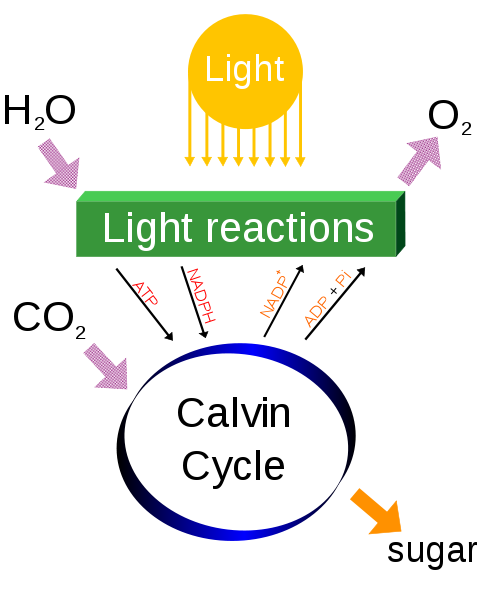Nutrition
The Coast Douglas Fir is phototrophic meaning it produces its own food. It does not rely on a host or any other organism to supply it with the necessary nutrients to grow. Instead, the Coast Douglas Fir undergoes photosynthesis to obtain its food.
Photosynthesis
Photosynthesis is the process of turning light energy into chemical energy which is then used by the plant for food. In order for this process to take place three elements are necessary: light energy, carbon dioxide, and and water. The resulting product is sugar.
Chemical Reaction:
6CO2 + 6H2O + light energy → C6H12O6 + 6O2
Along with creating sugar for the nutrition of the plant,
photosynthesis is also r esponsible for giving off the oxygen we
breath as a waste product. The whole process of photosynthesis
takes place in the mesophyll cells of the leaves. Inside the
mesophyll cells is the chlorophyll, the green pigment
responsible for photosynthesis. The chlorophyll is green due to
the absorption of red and blue light which is used as the light
energy in the process. Photosynthesis can be broken down into
two types of reactions: light reactions and dark reactions.
During the light reaction, light energy is converted into
chemical energy inside the thylakoid membrane. The energy is
then stored as ATP (adenosine triphosphate) which has been
compared to the building blocks of DNA. The dark reactions take
place in the stomata of the chloroplast where they convert
carbon dioxide into sugars. Though light energy is not directly
necessary in this step of the photosynthetic process, the
products of it are essential. The last step of photosynthesis is
the Calvin Cycle which results in the formation of sugars from
carbon dioxide and ATP. Photosynthesis is an ongoing process
necessary to the survival of the Coast Douglas Fir.
esponsible for giving off the oxygen we
breath as a waste product. The whole process of photosynthesis
takes place in the mesophyll cells of the leaves. Inside the
mesophyll cells is the chlorophyll, the green pigment
responsible for photosynthesis. The chlorophyll is green due to
the absorption of red and blue light which is used as the light
energy in the process. Photosynthesis can be broken down into
two types of reactions: light reactions and dark reactions.
During the light reaction, light energy is converted into
chemical energy inside the thylakoid membrane. The energy is
then stored as ATP (adenosine triphosphate) which has been
compared to the building blocks of DNA. The dark reactions take
place in the stomata of the chloroplast where they convert
carbon dioxide into sugars. Though light energy is not directly
necessary in this step of the photosynthetic process, the
products of it are essential. The last step of photosynthesis is
the Calvin Cycle which results in the formation of sugars from
carbon dioxide and ATP. Photosynthesis is an ongoing process
necessary to the survival of the Coast Douglas Fir.
Photosynthesis is an important part of the Coast Douglas Fir's nutrition cycle, but along with that is the importance of efficient mineral nutrients and water uptake. This is done with the help of the tree's xylem and phloem. The xylem is a vascular tissue that moves the water and minerals from the roots to other parts of the tree. The phloem is another type of vascular tissue that is responsible for the movement of sugars and other nutrients throughout the tree. Without these two essential parts of the tree, nutrients and water would not be able to travel to all of the parts of the plant.
Now that you know how the Coast Douglas Fir
gets its food lets take a look at how it reproduces. Check out
the
Life Cycle and Reproduction page to find out!
This page was created by Morgan Cook
Contact me at:
cook.morg@students.uwlax.edu